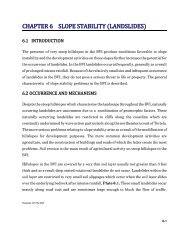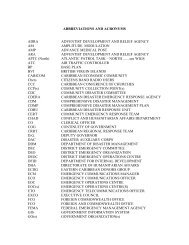Developers
Homeowners Handbook - The Department of Disaster Management
Homeowners Handbook - The Department of Disaster Management
- No tags were found...
You also want an ePaper? Increase the reach of your titles
YUMPU automatically turns print PDFs into web optimized ePapers that Google loves.
Lap and securely tie all reinforcement that is not continuous. Fillblock cores after laying every three courses with well-compactedconcrete or poured grout.For wood construction, use-reinforcing straps at the foundation tothe header at the floor, diagonally tying studs, strapping corner studassemblies at third points, and tying rafters to top plates.5.2.7 Gravel - refers to small stones, generally 5-30 mm in diameter thatmay be angular or rounded. Angular gravels are usually sourced fromquarries, a by-product of the crushing processes, whereas roundedgravels are from a fluvial source, such as an old river bed, beaches, andchannel dredging. Gravels can be of almost any colour, depending on theparent rock type, or even a multi-coloured blendThe gravels most commonly used as a loose surface dressing are in the 6-20 mm size range. Anything less than 6 mm is more akin to a grit and istoo easily disturbed; anything over 18-20 mm can be difficult to walkupon. In general, the smaller 6-10 mm gravels would be used forfootpaths and the 10-18 mm gravels for driveways, but it really is amatter of personal taste. One deciding factor could be that, the smallerthe gravel, the more the cats like to use it as a toilet!54










